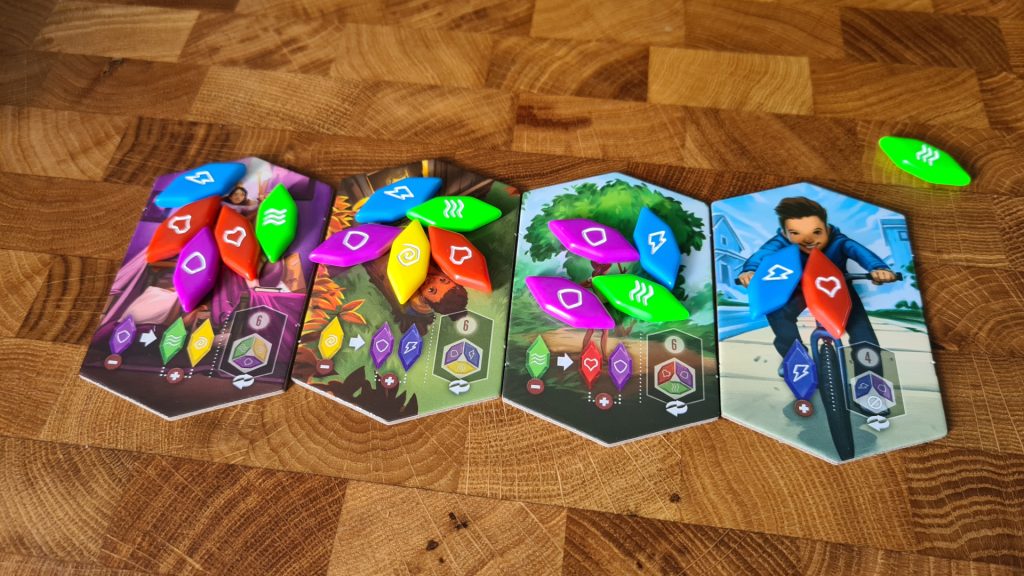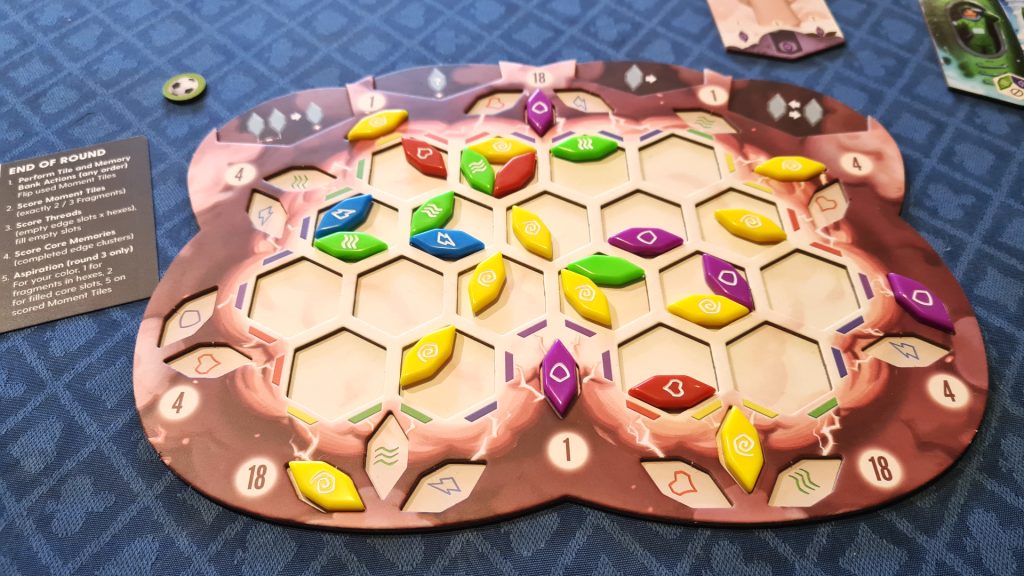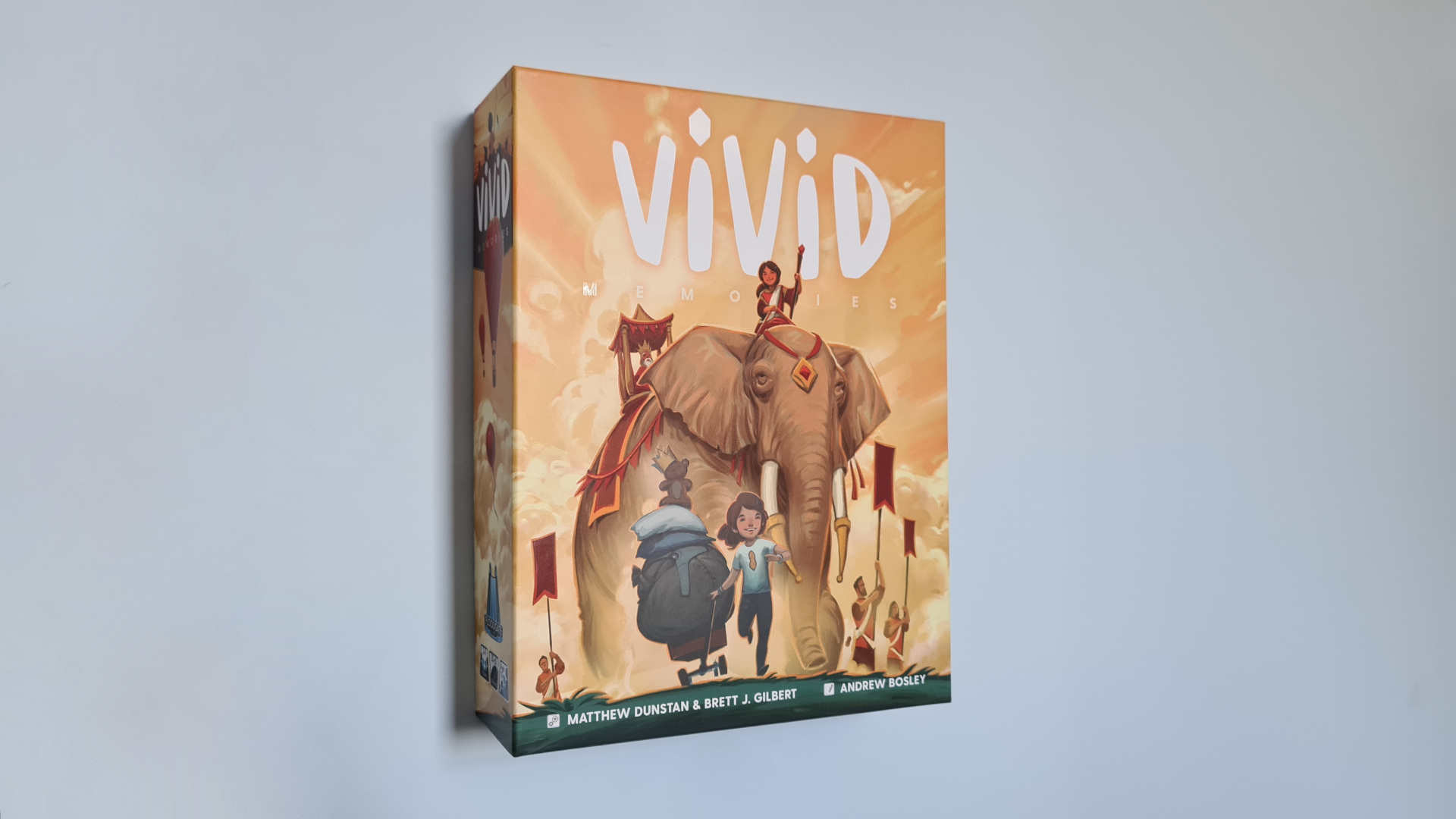Vivid Memories is the brand new pattern building board game from Floodgate Games. Designed by the wonderful duo of Matthew Dunstan and Brett J. Gilbert, featuring artwork from Andrew Bosley, the game sees 2 – 4 players collecting memories, and importantly remembering them. By drafting fragments players will weave memories across their board, but who will have the best childhood memories at the end of play? Let’s find out if this is child-like fun!
Players start by taking one of the four player boards. Each has unique colour positions around the edge of the boards, but are otherwise the same. Shuffling the 5 aspiration tiles, one is dealt to each player giving them their secret objective colour for end game scoring. Based on the player count a number of fragments of the five colours are put into the bag, with the rest put into a supply off to one side. Then, after shuffling the 20 moment tiles, the first of four rounds is ready to begin.
Each round is made up of 4 stages: Prepare, Remember, Reflect and Reward. During the Prepare phase a number of moment tiles are placed into a row, the amount based on the player count. Five fragments are then added to the moment tiles randomly from the bag, apart from at 2 players when only 4 are added. This is done at the start of each round in a matter of seconds.
Remember is the main part of each round and sees players gaining those fragment tokens and potentially moment tiles too. Going clockwise around the table players will choose to take 1, 2 or 3 fragment tiles, bearing in mind a few rules. Players can only take tiles from one of the two moment tile row ends. If taking two tiles they must be the same colour, while to take three they must all be different colours. If by taking tiles a moment tile is emptied the player is free to continue taking fragments from the new row end tile, as long as it follows the rules for taking 2/3 fragments. Emptying a moment tile sees the player gain it. All of the fragments taken must be placed into a single empty space on the player’s personal board.

Players are also able to take a single fragment, enabling them to perform a bonus rewire action. Rewiring is one of the only ways to move fragment tiles on your personal board. Players can either choose one space and move as many tiles into it or out of it – with spaces having a fragment limit of 3. Why this is helpful is due to the way players will want to craft chains of colours across their boards to score, as well as to make spaces contain specific coloured fragments. Turns continue clockwise until all fragments have been taken, which in turn means all moment tiles have been taken too.
The Reflect phase is where players trigger specific actions, including those on moment tiles they acquired in the round. The player boards have 4 standard actions which the players may activate. These abilities range from trading any 2 fragments in a space for a fragment of any colour to gaining a random fragment from the bag. For each moment tile they acquired they must cover up one of the standard actions – with the moment tiles coming with their own slight variations of those abilities. Using the action of a moment tile activates it flipping it over to its scoring side.
The final part of each round is the Reward phase, which unsurprisingly rewards players with points. Moment tiles on their scoring side depict 2 or 3 fragments. For each space on the player’s board that has the depicted fragments, and only those, they score points. Scoring a moment tile at least once sees it removed and put next to the player’s board in a scoring pile.
Next, players determine if they have traced any continuous links of fragments in a single colour across their personal boards, with sections around the boards showing specific colours. These threads are scored by counting the number of spaces in the thread across the board, by how many empty core spaces have been linked. At the start all the core spaces are empty but when scoring a thread the fragments adjacent to these spaces are moved to fill the spots.
After everyone has scored, play moves onto the next round. In the final round there is one bonus scoring phase. Players flip over their secret aspiration tile to reveal their bonus colour. For every moment tile, fragment tile on their player board and core memory slots of their aspiration colour they gain points. Counting this all up with the points earned during play, the winner is whoever has the most points – with ties split by points gained from their aspiration colour.

The method for choosing tiles is somewhat like that seen in the popular Azul series. Taking tiles from central cards isn’t just about choosing what is good for you. It can also be about what to leave and what may be bad for the next player, thus it presents a real choice. Making it so that there isn’t an endless choice, the logic of all the tiles being placed into the one space on your player board does limit the otherwise colossal scope for analysis paralysis. The choice isn’t as streamlined as in Azul though, trading the simplicity for options. More choice in this case works for the puzzle, though does make it more to teach and understand. It’s also not overly helped by a rulebook that undersells the value of taking single tiles to slightly rearrange.
Throughout the game players are aiming to get routes across their board complete. There’s a sense of satisfaction and a windfall of points when this is accomplished. It’s an intuitive objective players instantly see and understand when they sit down to play. The same cannot be said for the powers used during the reflect phase, though after a game or two this becomes easy to recognise and some player aid cards with reminders are included – so no need to dive constantly back to the rulebook.
In the first rounds the game feels like it’s not giving players enough to score anything. At this point players are crying out for more fragments. By the end of the game the puzzle pieces come together and you realize that the first rounds are there to enable players to build a strong base to score and build upon. Players are awarded with points from many methods at the end of the game, helping each decision along the route to have felt important. Players can struggle to calculate their best options to score big in the final round, and some paralysis at the options could creep in, but it’s an interesting puzzle to try to crack.
When it comes to production quality Vivid Memories is solid. The acrylic tiles are vibrant in colour (though also have symbols on them to differentiate above just colour). They add that level of touch and feel to the game that cardboard tokens couldn’t have. The dual layered player boards also help elevate the production of the game. One issue is that a dark blue colour has been used on the tiles and it vastly differs from the light blue fragment tiles. In some lights it’s been possible to slightly confuse it with purple during play. In a game all about the colours linking up this can be a problem.
It takes a couple of games to get how everything comes together in Vivid Memories. Seeing how as the rounds progress players can line themselves up for big point rewards is key, so those that have played before will have an advantage over new players. There’s an interesting puzzle there though, albeit one that some might get analysis paralysis from. Still, with strong production value Vivid Memories is certainly a game to check out as we move into convention season!
(Editor’s Note: Vivid Memories was provided to us by Asmodee for the review. The game is currently available from local board game stores! Find your local store here.)

